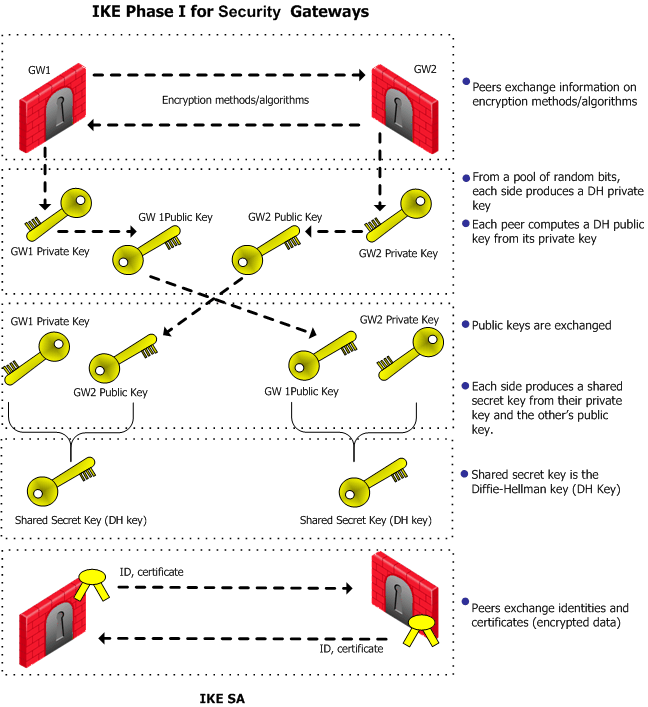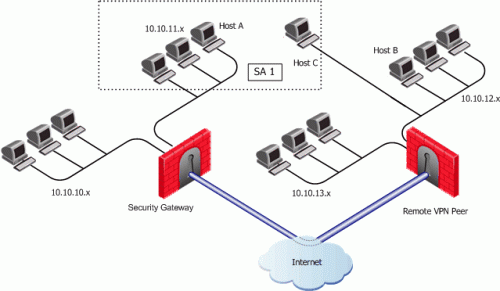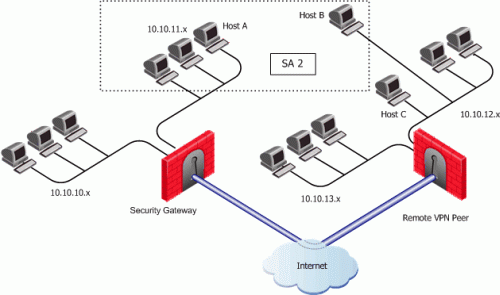


In This Section: |
In symmetric cryptographic systems, both communicating parties use the same key for encryption and decryption. The material used to build these keys must be exchanged in a secure fashion. Information can be securely exchanged only if the key belongs exclusively to the communicating parties.
The goal of the Internet Key Exchange (IKE) is for both sides to independently produce the same symmetrical key. This key then encrypts and decrypts the regular IP packets used in the bulk transfer of data between VPN peers. IKE builds the VPN tunnel by authenticating both sides and reaching an agreement on methods of encryption and integrity. The outcome of an IKE negotiation is a Security Association (SA).
This agreement upon keys and methods of encryption must also be performed securely. For this reason, IKE is composed of two phases. The first phase lays the foundations for the second. Both IKEv1 and IKEv2 are supported in Security Gateways of version R71 and higher.
Diffie-Hellman (DH) is that part of the IKE protocol used for exchanging the material from which the symmetrical keys are built. The Diffie-Hellman algorithm builds an encryption key known as a "shared secret" from the private key of one party and the public key of the other. Since the IPsec symmetrical keys are derived from this DH key shared between the peers, at no point are symmetric keys actually exchanged.
During IKE Phase I:
In terms of performance, the generation of the Diffie-Hellman Key is slow and heavy. The outcome of this phase is the IKE SA, an agreement on keys and methods for IKE phase II. Figure below illustrates the process that takes place during IKE phase I.
Note - The exact negotiation stages differ between IKEv1 and IKEv2.

IKE phase II is encrypted according to the keys and methods agreed upon in IKE phase I. The key material exchanged during IKE phase II is used for building the IPsec keys. The outcome of phase II is the IPsec Security Association. The IPsec SA is an agreement on keys and methods for IPsec, thus IPsec takes place according to the keys and methods agreed upon in IKE phase II.
After the IPsec keys are created, bulk data transfer takes place:
IKEv2 is supported inside VPN communities working in Simplified mode.
IKEv2 is configured in the VPN Community Properties window > Encryption. The default setting is IKEv1 only. IKEv2 is automatically always used for IPv6 traffic. The encryption method configuration applies to IPv4 traffic only.
For Remote users, the IKE settings are configured in Global Properties > Remote Access > VPN Authentication and Encryption. IKEv2 is not supported for Remote Access.
Note - IKEv2 is not supported on UTM-1 Edge devices or VSX objects before R75.40VS. If UTM-1 Edge devices or such VSX objects are included in a VPN Community, the Encryption setting should be Support IKEv1.
Two parameters are decided during the negotiation:
Parameter |
IKE Phase 1 (IKE SA) |
IKE PHASE 2 (IPSec SA) |
|---|---|---|
Encryption |
|
|
Integrity |
|
|
NULL means perform an integrity check only; packets are not encrypted.
The Diffie-Hellman key computation (also known as exponential key agreement) is based on the Diffie Hellman (DH) mathematical groups. A Security Gateway supports these DH groups during the two phases of IKE.
Parameter |
IKE Phase 1 (IKE SA) |
IKE Phase 2 (IPSec SA) |
|---|---|---|
Diffie Hellman Groups |
|
|
A group with more bits ensures a key that is harder to break, but carries a heavy cost in terms of performance, since the computation requires more CPU cycles.
Between Security Gateways, there are two modes for IKE phase I. These modes only apply to IKEv1:
If aggressive mode is not selected, the Security Gateway defaults to main mode, performing the IKE negotiation using six packets; aggressive mode performs the IKE negotiation with three packets.
Main mode is preferred because:
When dealing with remote access, IKE has additional modes:
IKE phase I is more processor intensive than IKE phase II, because the Diffie-Hellman keys have to be produced, and the peers authenticated, each time. For this reason, IKE phase I is performed less frequently. However, the IKE SA is only valid for a certain period, after which the IKE SA must be renegotiated. The IPsec SA is valid for an even shorter period, meaning many IKE phase II's take place.
The period between each renegotiation is known as the lifetime. Generally, the shorter the lifetime, the more secure the IPsec tunnel (at the cost of more processor intensive IKE negotiations). With longer lifetimes, future VPN connections can be set up more quickly. By default, IKE phase I occurs once a day; IKE phase II occurs every hour but the time-out for each phase is configurable.
Configure the frequency of IKE and IPsec Security Associations in SmartConsole: VPN Community Properties > Advanced.
The keys created by peers during IKE phase II and used for IPsec are based on a sequence of random binary digits exchanged between peers, and on the DH key computed during IKE phase I.
The DH key is computed once, then used a number of times during IKE phase II. Since the keys used during IKE phase II are based on the DH key computed during IKE phase I, there exists a mathematical relationship between them. For this reason, the use of a single DH key may weaken the strength of subsequent keys. If one key is compromised, subsequent keys can be compromised with less effort.
In cryptography, Perfect Forward Secrecy (PFS) refers to the condition in which the compromise of a current session key or long-term private key does not cause the compromise of earlier or subsequent keys. Security Gateways meet this requirement with a PFS mode. When PFS is enabled, a fresh DH key is generated during IKE phase II, and renewed for each key exchange.
However, because a new DH key is generated during each IKE phase I, no dependency exists between these keys and those produced in subsequent IKE Phase I negotiations. Enable PFS in IKE phase II only in situations where extreme security is required.
The supported DH groups for PFS are: 1, 2, 5, 14, 19, and 20. The default is group 2 (1042 bits).
Configure this in VPN Community Properties > Encryption > IKE Security Association (Phase 2) > Use Perfect Forward Secrecy.
Note - PFS mode is supported only between gateways, not between Security Gateways and remote access clients.
IP compression is a process that reduces the size of the data portion of the TCP/IP packet. Such a reduction can cause significant improvement in performance. IPsec supports the Flate/Deflate IP compression algorithm. Deflate is a smart algorithm that adapts the way it compresses data to the actual data itself. Whether to use IP compression is decided during IKE phase II. IP compression is not enabled by default.
IP compression is important for Remote Access client users with slow links.
Security Gateway encryption makes TCP/IP packets appear "mixed up". This kind of data cannot be compressed and bandwidth is lost as a result. If IP compression is enabled, packets are compressed before encryption. This has the effect of recovering the lost bandwidth.
By default, a VPN tunnel is created for the complete subnets that host computers reside on, and not just for the host computers involved in the communication.
If you disable the Support Key exchange for subnets option on each Security Gateway, you can create a unique Security Association for a pair of peers.

If the Security Gateway is configured to Support key exchange for subnets but the option is unsupported on the remote peer, when host A communicates with host C, a Security Association (SA 1) will be negotiated between host A's subnet and host C's IP address. The same SA is then used between any host on the 10.10.11.x subnet and Host C.
When host A communicates with host B, a separate Security Association (SA 2) is negotiated between host A's subnet and host B. As before, the same SA is then used between any host in 10.10.11.x subnet and Host B.

When Support Key exchange for subnets is not enabled on communicating Security Gateways, then a security association is negotiated between individual IP addresses; in effect, a unique SA per host.
Denial of Service (DoS) attacks are intended to reduce performance, block legitimate users from using a service, or even bring down a service. They are not direct security threats in the sense that no confidential data is exposed, and no user gains unauthorized privileges. However, they consume computer resources such as memory or CPU.
Generally, there are two kinds of DoS attack. One kind consists of sending malformed (garbage) packets in the hope of exploiting a bug and causing the service to fail. In the other kind of DoS attack, an attacker attempts to exploit a vulnerability of the service or protocol by sending well-formed packets. IKE DoS attack protection deals with the second kind of attack.
The IKE protocol requires that the receiving Security Gateway allocates memory for the first IKE Phase 1 request packet that it receives. The Security Gateway replies, and receives another packet, which it then processes using the information gathered from the first packet.
An attacker can send many IKE first packets, while forging a different source IP address for each. The receiving Security Gateway is obliged to reply to each, and assign memory for each. This can consume all CPU resources, thereby preventing connections from legitimate users.
The attacker sending IKE packets can pretend to be a machine that is allowed to initiate IKE negotiations, such as a Check Point Security Gateway. This is known as an identified source. The attacker can also pretend to have an IP address that the receiving Security Gateway does not know about, such as a Remote Access client, or a Check Point Security Gateway with a dynamic IP address. This is known as an unidentified source.
When the number of simultaneous IKE negotiations handled exceeds the accepted threshold, it concludes that it is either under load or experiencing a Denial of Service attack. In such a case, the Security Gateway can filter out peers that are the probable source of a potential Denial of Service attack. The following sections describe different types of defenses against IKE DoS attacks.
IKE DoS protection is not supported for IPv6 addresses.
To protect against IKE DoS attacks, configure the SmartConsole IKE Denial of Service Protection settings, in the VPN >Advanced page of the Global Properties. IKE DoS protection is not supported for IPv6 addresses.
If the source is identified, protecting using Puzzles is over cautious, and may affect performance. A third possible setting is None, which means no DoS protection.
For unidentified sources, Stateless protection may not be sufficient because an attacker may well control all the IP addresses from which the IKE requests appear to be sent. A third possible setting is None, which means no DoS protection.
Advanced IKE DoS attack protection can be configured on the Security Management server using the Check Point Database Tool (see sk13009). Configure the protection in the Global Properties shown. IKE DoS protection is not supported for IPv6.
Values: 0-100. Default: 70. Determines the percentage of maximum concurrent ongoing negotiations, above which the Security Gateway will request DoS protection. If the threshold is set to 0, the Security Gateway will always request DoS protection.
Values: 0-32. Default: 19. Determines the level of the puzzles sent to known peer Security Gateways. This attribute also determines the maximum puzzle level a Security Gateway is willing to solve.
Values: 0-32. Default: 19. Determines the level of the puzzles sent to unknown peers (such as Remote Access clients and DAIP Security Gateways). This attribute also determines the maximum puzzle level that DAIP Security Gateways and Remote Access clients are willing to solve.
Values: 0-30000. Default: 500. Determines the maximum time in milliseconds a Security Gateway is willing to spend solving a DoS protection puzzle.
Values: 0-30000. Default: 500. Determines the maximum time in milliseconds a DAIP Security Gateway is willing to spend solving a DoS protection puzzle.
Values: 0-30000. Default: 5000. Determines the maximum time in milliseconds a client is willing to spend solving a DoS protection puzzle.
Values: None, Stateless, Puzzles. Default: Puzzles. When downloaded to a client, it controls the level of protection the client is willing to support.
Security Gateways use the ike_dos_protection_unidentified_initiator property (equivalent to the SmartConsole Global Property: Support IKE DoS Protection from unidentified Source) to decide what protection to require from remote clients, but / SecureClient clients use the ike_dos_protection. This same client property is called ike_dos_supported_protection_sr on the Security Gateway.
You can configure fields in GuiDBedit Tool (see sk13009) or dbedit (see skI3301) to protect against IKE DoS attacks from peers who may authenticate successfully and then attack a Security Gateway. These settings are configured in the Global Properties table and not per Security Gateway. By default these protections are off. Once you enter a value, they will be activated.
To limit the amount of IKE Security Associations (SA's) that a user can open, configure the following fields:
Type of VPN |
Field |
Recommended Value |
Site to site |
|
5 |
Remote user |
|
5 |
To limit the amount of tunnels that a user can open per IKE, configure the following fields:
Type of VPN |
Field |
Recommended Value |
Site to site |
|
30 |
Remote user |
|
5 |
Some Security Gateway properties change name when they are downloaded to Remote Access VPN Clients. The modified name appears in the Userc.C file, as follows:
Property Names
Property Name on Gateway |
User.C Property name on Client |
|---|---|
ike_dos_protection_unidentified_initiator |
ike_dos_protection or |
ike_dos_supported_protection_sr |
ike_dos_protection |
ike_dos_puzzle_level_unidentified_initiator |
ike_dos_acceptable_puzzle_level |
ike_dos_max_puzzle_time_sr |
ike_dos_max_puzzle_time |
IKE is configured in two places:
IPv6 automatically works with IKEv2 encryption only. The option that you select here, applies to IPv4 traffic.
To configure a VPN Community object:
The Community object window opens and shows the Gateways page.
Encryption Method
Encryption Suite
Note - Suite-B GCM-128 and 256 encryption suites are supported on R71.50 gateways and from R75.40 gateways.
If there is a Dynamic IP Gateway inside the community, R77.30 (or lower) community member gateways that respond to its IKE negotiation, use the configuration defined in Global Properties > Remote Access > VPN -Authentication and Encryption.
More
Configure these options in the VPN Community object Advanced page:
IKE (Phase 1)
When to renegotiate the IKE Security Associations.
IKE (Phase 2)
When to renegotiate the IPsec security associations. This sets the expiration time of the IPsec encryption keys.
NAT
Disable NAT inside the VPN community - Select to not apply NAT for the traffic while it passes through IPsec tunnels in the community.
Reset
Reset all VPN properties to the default.
Note - Wire Mode is not supported for IPv6 connections.
If you have many employees working remotely, you may want to raise the default values.